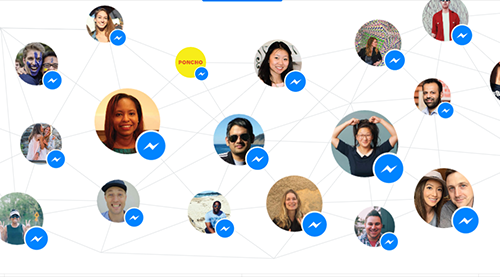Last week brands, technology vendors and advertising agencies finally understood how popular the much anticipated Facebook Messenger bot store is set to be. It’s been several months since the social media giant released an SDK that would allow developers to build branded bots – essentially enabling brands and advertisers to create one-to-one conversations with consumers right within the popular messaging app. It was just over a week ago that messaging giant Kik announced its own bot store which has received a lot of positive attention in the tech and branding community.
So what are these bots all about? Hasn’t automated chat been around for at least a decade or more? The short answer is: yes, bots aren’t necessarily new as a technology concept, however the bots we know today are much more sophisticated than they were just a couple of years ago. With the use of mobile messaging applications continuing to surge (Activate expects there to be 3.6 billion people using messaging apps by 2018), there’s a huge opportunity for brands to engage with consumers in new ways, and in the place they spend the most time. Bots allow brands to become a part of the consumer conversation – rather than an interruption, and reach millennials in a way that traditional advertising can’t with a one-to-one, highly scalable and personalised approach.
Bots put a brand in the middle of one of the world’s largest conversations – the mobile messaging space. However, not all chat bots are created equal. There are two very distinctly different kind of bots in the market today: Artificial Intelligence or natural language bots (like Microsoft Tay) and scripted bots which is what most brands are testing out today on major platforms like Kik. AI, while a sophisticated technology, poses a number of risks when it comes to tricking the system – which we saw with Tay. The information going in impacts the information that comes back out, which can sometimes be unexpected or unflattering. There’s no doubt that AI bots will become smarter and more effective the longer they’re in market, but the most effective way for brands to test the bot waters today is through scripted bots.
Scripted chat bots will soon become an integral part of brands’ mobile engagement strategies. Much like the way that many jumped on the branded emoji phenomenon last year – chat bots offer brands an extension of that method of marketing by making it easy, natural, and fun for the consumer to engage with without feeling like it’s an advertisement or marketing.
Think of the scripted bot as a guided conversation. For instance, Sephora (a popular makeup retailer in the U.S.) recently launched a bot on the Kik store. Today, the bot engages users with a number of questions about makeup preferences and serves up content and offers relevant to the responses. While it doesn’t sound like a highly sophisticated process – the more the consumer engages with the bot over time, the smarter the bot (and the brand) get about consumer preferences and can serve personalised content and offers. The most important part is that the brand is front and center to the consumer and engaging them with interesting and useful content – hopefully driving them through the sales conversion process.
Imagine another scenario where you just bought a bottle of tequila and you want to find some fun cocktail recipes for your Cinco de Mayo party. Hypothetically, you could engage your favorite tequila brand’s bot and ask “what are some mixed drink recipes?” and you’ll likely be served up a cocktail list that will impress your party guests. In turn, the brand is learning more about their own customers’ preferences, so the type of content they’re looking for and if that content makes them happy. With that information and response, the brand can better inform the bot for future interactions with consumers. The more it’s engaged, the smarter and more efficient it becomes.
Yet, like the planning of any other branding, marketing or advertising campaign – brands should think about how they can layer the chat bot experience with other engagement experiences. If your chat bot strategy is to promote a new film – it may be effective to compliment the bot experience with short video trailers or GIFs in the mobile messaging app store to drive people to the bot experience – which can provide movie show times and ultimately drive users to a ticket purchasing page. Bots won’t likely sustain interest and engagement on their own, they must be supported with other campaign elements that drive awareness and interest. And not all bot platforms will promise traffic. So, before you invest, it’s best to double down on the campaign to ensure you have a way to drive traffic to the bot experience.
By doing that, you’ve created a full circle branded content library that will entice consumers to use the content in their conversations with friends – and build interest, awareness and hype around your film. You’ve got an army of brand advocates yearning for and sharing your content in a place where they are spending most of their time talking to their friends.
It’s also important to know your audience. Kik, for instance, may offer different value and reach a different demographic than running a campaign in Facebook Messenger or Viber. It’s important to work with a platform-agnostic partner that can help develop a proposal and theme that will align with your campaign goals. They’ll also help you look at all of the options available in the bot market and provide strategic advice and expertise on how to best use and deploy branded creative assets, and then effectively measure the success of those campaigns.
Finally, it’s crucial that the brand has access to real-time analytics of a campaign. They should make sure they have a constant update on things like the read rate of the bot messages, the timestamp on the average back and forth conversation that’s happening with each user in the bot, how many people went through the funnel to reach the KPIs (clinking a link or making a purchase), and an understanding of the sentiment (was it a positive or negative experience overall). These insights will be critical to overall engagement and to the long term success of the campaign.
Bots are going to explode and the phenomenon is sure to run through into the going foreseeable future – and there’s no question that they’re already dominating the news right now.
If you’re a brand exploring how to use chat bots as a part of your mobile engagement strategy it will be important to think of all of the steps above to ensure your execution is as great as your idea.






